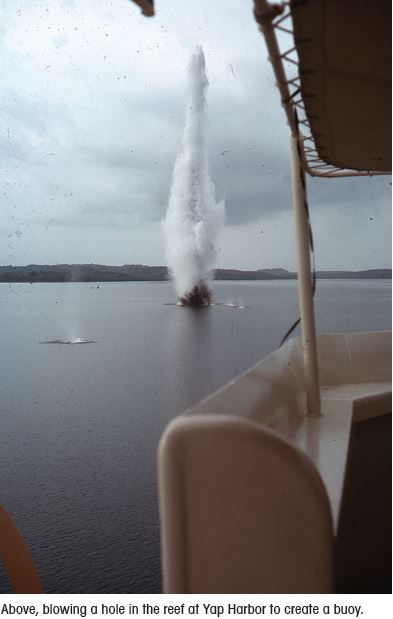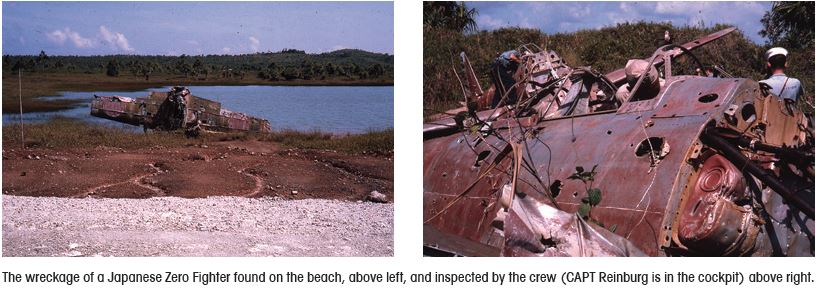Yap is a small island in the Western Caroline Islands southwest of Guam, Mariana Islands. In 1963 Yap was administered by the United States as a part of the United Nations Trust Territories of the Pacific Islands. After World War I, Yap was a part of the League of Nations Mandate administered by Japan. However, after World War II, Japan’s control of Yap, together with the remaining islands of the Mandate, was terminated, and it was placed under the tutelage of the United Nations.
From the time that Japan’s Mandate started, it violated the terms of the Mandate by building military bases on all of the main islands, ostensibly for “national defense,” but it was obviously for a more sinister reason, as World War II demonstrated. As soon became obvious, it allowed them to extend their military control over a broad expanse of the southwest Pacific as WWII began. Yap, for example, became a major military air base. As these islands began to be retaken by the U.S. these strategic islands became available for the installation of electronic aids to navigation stations, which greatly expanded the scope and coverage of the U.S. main all weather navigation system, that is Loran-A. Loran-A was a secret medium frequency, hyperbolic system that provided positioning information to ships and aircraft equal in accuracy to celestial navigation, that is 1 to 2 miles, in its coverage area, despite overcast conditions. This was huge benefit in an area known for its frequent overcast conditions.
Loran-A was indispensable all during WWII; however, it had its limitations. For example, due to its limited range, it required an extensive number of stations to cover the wide expanses of the Pacific. A newer system became available in the late 1950s and 1960s, known as Loran-C, which had the advantage of longer range, lower frequency and higher power, and higher accuracy. This of course meant fewer stations covering a greater area with greatly improved accuracy. Yap Island became a prime location for one of these new stations.
In 1963, I was the Commanding Officer of the Coast Guard buoy tender IRONWOOD (WAGL-297), stationed in Honolulu, Hawaii. My ship was tasked with putting a mooring buoy in Yap Harbor, a very small harbor, barely accessible to large ships. The purpose of this buoy was to accommodate the Coast Guard cargo ship the KUKUI, carrying construction material, whose length made it impossible for it to swing around a conventional anchor. The mooring buoy mooring was required to be placed in a hole blown in the harbor fringing reef, which was then to be filled by concrete, sealing in a 2,000-pound concrete sinker attached to a heavy chain which would lead up to the buoy. When the ship was moored to the buoy, it would drop a stern anchor, and between these two would keep the ship from swinging, and thus grounding on the reef. The IRONWOOD would accomplish this task during its regular five-month “round robin” Western Pacific (WESTPAC) aids-to-navigation voyage.
I understood in theory how this was to be done but could anticipate a number of problems. First and foremost among the anticipated problems was pouring concrete under salt water. No one in the District staff had ever poured concrete under salt water and had no idea how to advise me what to do. My last advice was to “improvise.” In other words, I was on my own. But they did have confidence in me that I would “find a way.” With these words of advice I was on my way. The Coast Guard prides itself on its ability to improvise.
Since Yap was at the far reaches of our voyage, we accomplished a significant portion of our aids-to-navigation work enroute. During our lengthy trip to Yap, I conferred with the officers and crewmembers who would be doing the work. Although none had had any experience with pouring concrete under salt water (or any other kind of water), they were experienced in construction work, which we had to do on shore aids to navigation and had a wealth of knowledge and experience in buoy work. The advantage of this conferring allowed them to be thinking about the problem, and any other associated problems, which paid off handsomely in the work, which eventually we accomplished.
One additional Yap task was to do a hydrographic survey of the harbor. I assigned responsibility to a newly assigned Academy grad ensign, who did a magnificent, innovative job, and for which the ship received a congratulatory message from the District Commander. I made sure a proper recognition was given to the ensign in his fitness report.
Since no mention was made by the District staff about how the hole was to be blown in the reef, an essential part of the whole operation, I made provision for a Navy explosive ordnance demolition team to meet us at Yap. We carried the explosives from Guam to Yap, and the explosive ordnance demolition (EOD) team flew in to Yap on a Coast Guard aircraft furnished by the Coast Guard air detachment stationed in Guam and were there on Yap when we arrived. This was very helpful since they “scoped out” the job before our arrival and were ready to provide us with their requirements. These included providing them with small boat for the divers to look at that portion of the reef that required the hole to be blasted to accommodate the mooring buoy sinker.
Now I turned to the remaining problem to be addressed, that is, pouring the concrete under water. While I pondered the problem, Sunday rolled around, and I found that wonder of wonders, there was a Catholic Church on the island. I attended Mass, and afterward, the priest noticed an unfamiliar face in the congregation and invited me into the rectory for a cup of coffee. He was an American member of the Society of Jesus (a Jesuit.) He had been on Yap for a number of years and told me some of the 400-year-old history of this missionary outpost. It was a fascinating story, and he had volumes of records going back to the 1500s to back up the history, all kept in Latin. He recounted how during the last ten years, he had constructed small chapels all over the island, and on Sundays, he made a circuit of all of them, saying Mass. I thought I had an opening, and told him of our problem, that is, pouring concrete under salt water.
He turned around in his chair and pulled a civil engineering book off the shelf, which was dedicated to the uses of concrete. He opened the book and showed me a chapter titled “Pouring Concrete Under Water.” I had found the solution to my problem! I asked him if I could borrow the book and promised to return it promptly. He agreed, and I returned to the ship, jubilant. I gathered my team of experts together, and we reviewed the book thoroughly. They now had their key, and as I expected, developed a plan. One was detailed to arrange for a large barge, to be borrowed from the Trust Territory Representative, who also arranged for provision of a small cement mixer. The Engineer Officer began planning to fabricate a metal trough to be placed from the mixer, over the side and long enough to reach the bottom of the hole that was to be blown in the reef. This would allow the wet cement to settle in the bottom of the hole, rather being dispersed as it hit the water. I left them alone to develop the remaining details of the plan, confident that the arrangements were in good hands.
The next day, we met again to firm up the plan, which was put into effect the following day with the blowing of the hole in the reef. When the divers inspected the hole after the water had cleared, they found it to be larger than they expected, however, we compensated for this by using more cement. The concrete sinker with its heavy-duty chain was hoisted into the hole with the ship’s buoy crane. We were now in business. The next day we started mixing and pouring concrete. As the textbook predicted, the wet cement flowed and settled nicely in the bottom of the hole. We allowed several days for the concrete to set.
Due to expert planning and execution, the remainder of the project went exactly as expected. The mooring buoy was in place due to excellent coordination and assistance from the Trust Territories Representative and the Catholic Church, but most credit had to go our wonderful crew of experts on the ship, who made it all happen. I was proud of everyone, and I made certain that this was reflected in our official report. I made certain that everyone involved received official recognition in his personal file.
(Originally published in Officer Review, Vol. 49 No. 9, April 2010, The Military Order of the World Wars)

Well done! I serve at the LORSTA ’77-’78 and lived in Yap from ’80 to ’14. I now live in Guam and I believe the same buoy is still there.